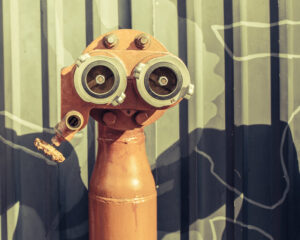On March 16, 2023, the U.S. Copyright Office (USCO) published its Copyright Registration Guidance: Works Containing Material Generated by Artificial Intelligence(the Guidance).
Artificial Intelligence (AI) is now “capable of producing expressive material”. The USCO chose its words carefully: AI “produces” works, it does not “create” them. However, these works are “expressive materials”.
AI is now among us, but not in the shape imagined by Isaac Asimov, androids, such as Robbie, who is taking care of a little girl. AI is on our desktop and in our pockets, an app installed on our smart phone.
AI technology can be used to produce a work by first obtaining a large data set of preexisting works, using this data set to “train” and then “use inferences from that training to generate new content.” Such content can be a text, an image, or an audio. The USCO mentioned in the Guidance that it would later this year publish a notice of inquiry about how law should address the use of works protected by copyright in the data set.
The USCO mentioned two recent cases raising the issues of whether a work created using an AI program can be protected by copyright: “Entrance to Paradise”, pictural work, and Zarya of the Dawn, a comic book which images were created by AI while a human authored the text. Are the works thus produced protectable by copyright?
An Entrance to Paradise
Dr. Stephen Thaler created A Recent Entrance to Paradise, the image of an abandoned train tracks framed by wisterias, using an AI program it called the “Creativity Machine” that he had created and programmed.
Dr. Thaler sought to register its copyright in November 2018 but the USCO denied registration in August 2019, because the Office has a “Human Authorship Requirement” policy. Dr. Thaler filed two requests for reconsideration which the USCO both denied. Dr. Thaler filed a suit against the USCO in June 2022, claiming that “the denial creates a novel requirement for copyright registration that is contrary to the plain language of the Copyright Act…, contrary to the statutory purpose of the Act, and contrary to the Constitutional mandate to promote the progress of science.” The denials are subject to judicial review under the Administrative Procedure Act, 5 U.S.C. § 704.
On January 10, 2023, Dr. Thaler filed a motion for summary judgment, arguing that “the plain language of the Copyright Act… does not restrict copyright to human-made works, nor does any case law.” The work is fixed, visual artwork. As explained in 1991 by the Supreme Court of the U.S. (SCOTUS) in Feist Publications, Inc. v. Rural Telephone Service Company “To qualify for copyright protection, a work must be original to the author”, which means that the work must be independently created by the author and must possess at least some minimal degree of creativity.
Dr. Thaler also argued that “courts have referred to creative activity in human-centric terms, based on the fact that creativity has traditionally been human-centric and romanticized.”
Alternatively, Dr. Thaler argued that he owns the copyright in “A Recent Entrance to Paradise” because the work for hire ownership originally vested in him because he invented and owns the Creativity Machine and its outputs automatically vest in him.
Zarya of the Dawn
Kristina Kashtanova, created a comic book, Zarya of the Dawn, using an AI program to illustrate it. She sought to register its copyright and was successful at first, but the USCO then canceled the certificate and issued a new one protecting only the text of the comic book and the selection, coordination, and arrangement of its written and visual elements. However, the images created by AI were not protectable because they “are not the product of human authorship.” The letter of the USCO cited Burrow-Giles Lithographic Co. v. Sarony, a 1884 case where SCOTUS explained that photographs, still a technological novelty at the time, were protected by copyright because they were “representatives of original intellectual conceptions of the author.” SCOTUS defined authors in Burrow-Giles as “he to whom anything owes its origin; originator; maker; one who completes a work of science or literature.” But the Court explained that if photography was a “merely mechanical” process …with no place for novelty, invention or originality” for the photographer, then the photographs could not be protected by copyright.
The USCO explained in its letter about Zarya of the Dawn that even if Ms. Kashtanova claimed to have “guided” the structure and content of the comic images, it was the AI program, not her, “that originated the “traditional elements of authorship” in the images.”
Public guidance on the registration of works containing AI
These two cases show that works can be entirely protected by AI or only partially. The purpose of the Guidance is to provide the public (and its attorneys!) if seeking to register works containing content generated (not created!) by AI.
In the Guidance, the USCO explained that it evaluated whether works containing human authorship combined by uncopyrightable material generated by or with assistance of technology by assessing if technology was an “assisting instrument” or if the work was conceived by it. In the case of AI, the USCO explained that it “will consider whether the AIA contributions containing AI-generated are the result of “mechanical reproduction “or instead an author’s “own original mental conception, to which [the author] gave visible form”, and that this would assessed case by case.
If the AI receives solely a prompt from a human being, the work cannot be protected by copyright, as it is the human being does not have creative control over how the AI system interprets the prompt and generate the work, and that the prompts are more like instructions to a commissioned artist.
If a work contains AI-generated material and sufficient human authorship, it can be protected by copyright, for instance, if a human being selects and arranges AI-generated materials in a way original enough to be protectable.
Public guidance on the registration of works containing AI
Does the Copyright Act indeed require human authorship?
The USCO cited Burrow-Giles in its Guidance to support its view that authors must be human and also cited the Ninth Circuit Urantia Found. v. Kristen Maahera case, where the court held that a book, which both parties believed was “authored by celestial beings and transcribed, compiled and collected by mere mortals.” The defendant in this copyright infringement suit claimed that the book was not protected by copyright, because it was not authored by a human being and thus not a “work of authorship” within the meaning of the Copyright Act.
However, the Ninth Circuit noted that “[t]he copyright laws, of course, do not expressly require “human” authorship, and considerable controversy has arisen in recent years over the copyrightability of computer-generated works”. In this case, the Court noted that the Copyright Act was not intended to protect “creations of divine beings” and that “in this case some element of human creativity must have occurred in order for the [b]ook to be copyrightable.”
If the Copyright Act does not require human authorship, but refuses to accept that “divine beings” can be the author, and case law states that a monkey, human beings’ closest cousin, cannot be an author within the meaning of the Copyright Act (Naruto v. Slater, a case from the United States District Court, Northern District of California previously discussed in the TTL Newsletter), will robots ever be able to claim authorship of a work? Such works are already winning prizes at art fairs, such as Théâtre D’opéra Spatial, created using AI, which won first prize at the Colorado State Fair’s digital arts competition.
If works created by AI cannot be protected by copyright, the incentive to develop such technology may be lacking. We are likely to see more and more works crated by humans using elements created by AI, and the border between elements crated by human beings or by machines blurring more and more.





